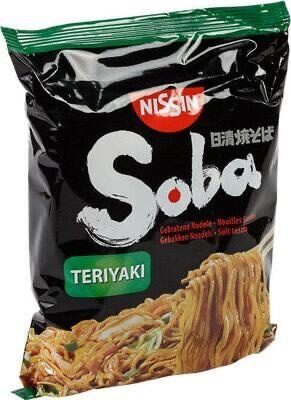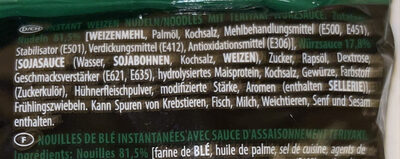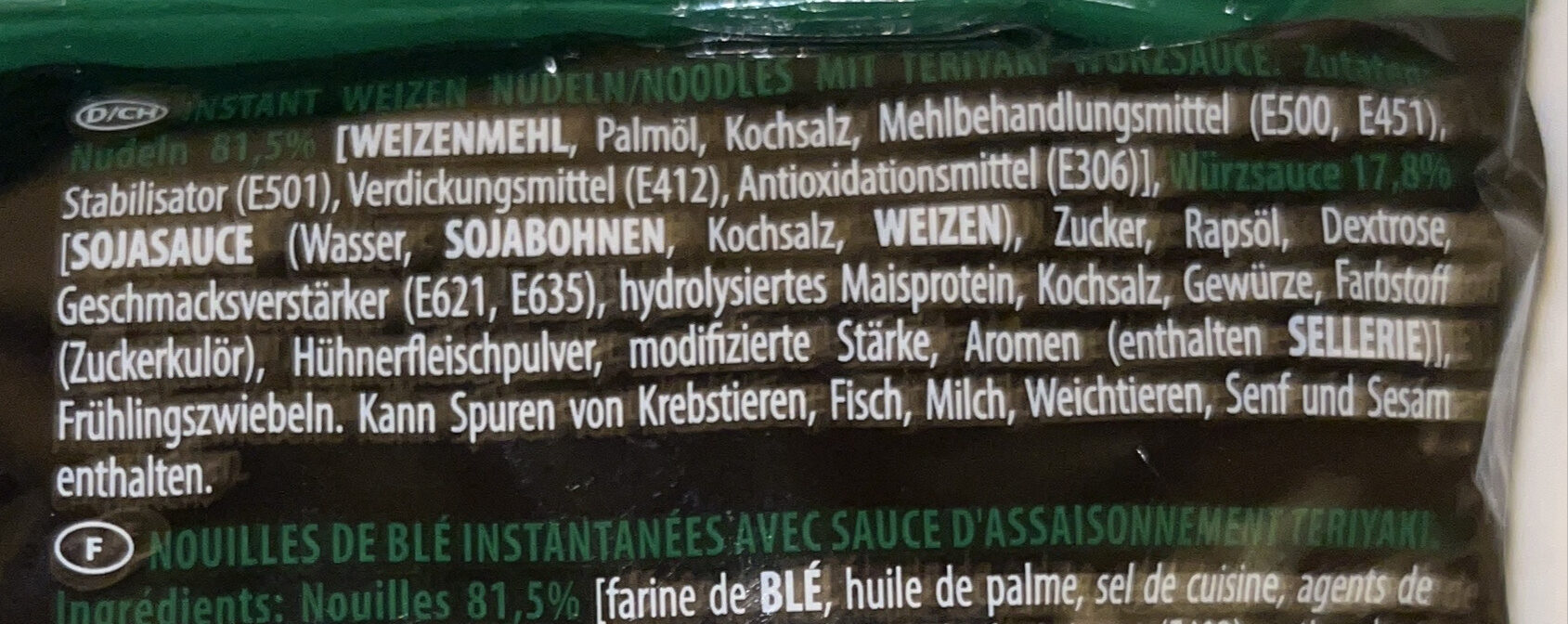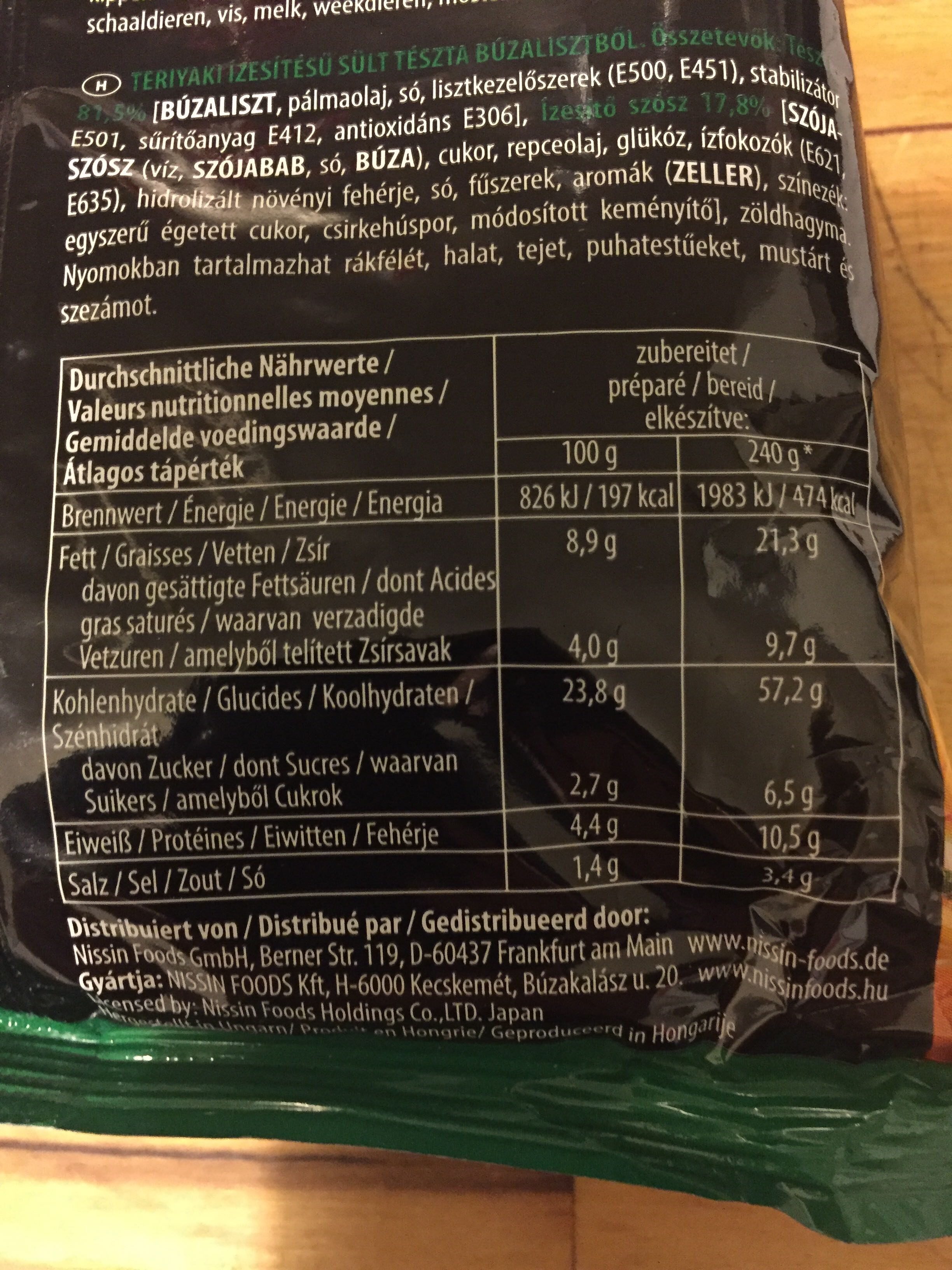Ajuda'ns a fer que la transparència alimentària sigui la norma!
Com a organització sense ànim de lucre, depenem de les vostres donacions per continuar informant els consumidors de tot el món sobre tot allò què mengen.
La revolució alimentària comença amb tu!
Soba Wok Style Terriyaki - Nissin - 110g
Soba Wok Style Terriyaki - Nissin - 110g
Aquesta pàgina del producte no està completa. Podeu ajudar a completar-la editant-la i afegint-hi més dades a partir de les fotos ja disponibles, o fent-ne més amb l'aplicació de androide o iPhone / iPad. Gràcies!
×
Codi de barres: 5997523324315 (EAN / EAN-13)
Quantitat: 110g
Empaquetament: Plàstic, en:Bag
Marques: Nissin
Categories: Aliments i begudes amb base vegetal, Aliments amb base vegetal, Cereals i patates, Cereals i derivats, Productes secs, Pasta, Productes assecats per a ser rehidratats, Fideus, en:Instant noodles, en:Instant noodle soups, Soba
Origen dels ingredients: Hongria
Botigues: Magasins U, Amazon, EDEKA
Matching with your preferences
Salut
Ingredients
-
37 ingredients
Alemany: Nudeln 81,5% [WEIZENMEHL, Palmöl, Kochsalz, Mehlbehandlungsmittel (E500, E451), Stabilisator (E501), Verdickungsmittel (E412), Antioxidationsmittel (E306)], Würzsauce 17,8% [SOJASAUCE (Wasser, SOJABOHNEN, Kochsalz, WEIZEN), Zucker, Rapsöl, Dextrose, Geschmacksverstärker (E621, E635), hydrolysiertes Maisprotein, Kochsalz, Gewürze, Farbstoff (Zuckerkulör), Hühnerfleischpulver, modifizierte Stärke, Aromen (enthalten SELLERIE)], Frühlingszwiebeln. Kann Spuren von Krebstieren, Fisch, Milch, Weichtieren, Senf und Sesam enthalten.Al·lèrgens: en:Celery, en:Gluten, en:SoybeansRastres: en:Crustaceans, en:Fish, en:Milk, en:Molluscs, en:Mustard, en:Sesame seeds
Processament d'aliments
-
Aliments ultra processats
Elements que indiquen que el producte està al grup 4 - Aliments i begudes ultraprocessats:
- Additiu: E14XX - Midó modificat
- Additiu: E150a - Colorant de caramel
- Additiu: E412 - Goma de guar
- Additiu: E451 - Trifosfat
- Additiu: E621 - Glutamat de monosodi
- Additiu: E635 - 5'-ribonucleòtid de disodi
- Ingredient: Color
- Ingredient: Dextrosa
- Ingredient: Potenciador del gust
- Ingredient: Aromes
- Ingredient: Glucosa
- Ingredient: Espessidor
Els productes alimentaris es classifiquen en 4 grups segons el seu grau de processament:
- Aliments no processats o mínimament processats
- Ingredients culinaris processats
- Aliments processats
- Aliments ultra processats
La determinació del grup es fa en funció de la categoria del producte i dels ingredients que conté.
Additius
-
E412 - Goma de guar
Guar gum: Guar gum, also called guaran, is a galactomannan polysaccharide extracted from guar beans that has thickening and stabilizing properties useful in the food, feed and industrial applications. The guar seeds are mechanically dehusked, hydrated, milled and screened according to application. It is typically produced as a free-flowing, off-white powder.Origen: Wikipedia (Anglès)
-
E451 - Trifosfat
Sodium triphosphate: Sodium triphosphate -STP-, also sodium tripolyphosphate -STPP-, or tripolyphosphate -TPP-,- is an inorganic compound with formula Na5P3O10. It is the sodium salt of the polyphosphate penta-anion, which is the conjugate base of triphosphoric acid. It is produced on a large scale as a component of many domestic and industrial products, especially detergents. Environmental problems associated with eutrophication are attributed to its widespread use.Origen: Wikipedia (Anglès)
-
E500 - Carbonats de sodi
Sodium carbonate: Sodium carbonate, Na2CO3, -also known as washing soda, soda ash and soda crystals, and in the monohydrate form as crystal carbonate- is the water-soluble sodium salt of carbonic acid. It most commonly occurs as a crystalline decahydrate, which readily effloresces to form a white powder, the monohydrate. Pure sodium carbonate is a white, odorless powder that is hygroscopic -absorbs moisture from the air-. It has a strongly alkaline taste, and forms a moderately basic solution in water. Sodium carbonate is well known domestically for its everyday use as a water softener. Historically it was extracted from the ashes of plants growing in sodium-rich soils, such as vegetation from the Middle East, kelp from Scotland and seaweed from Spain. Because the ashes of these sodium-rich plants were noticeably different from ashes of timber -used to create potash-, they became known as "soda ash". It is synthetically produced in large quantities from salt -sodium chloride- and limestone by a method known as the Solvay process. The manufacture of glass is one of the most important uses of sodium carbonate. Sodium carbonate acts as a flux for silica, lowering the melting point of the mixture to something achievable without special materials. This "soda glass" is mildly water-soluble, so some calcium carbonate is added to the melt mixture to make the glass produced insoluble. This type of glass is known as soda lime glass: "soda" for the sodium carbonate and "lime" for the calcium carbonate. Soda lime glass has been the most common form of glass for centuries. Sodium carbonate is also used as a relatively strong base in various settings. For example, it is used as a pH regulator to maintain stable alkaline conditions necessary for the action of the majority of photographic film developing agents. It acts as an alkali because when dissolved in water, it dissociates into the weak acid: carbonic acid and the strong alkali: sodium hydroxide. This gives sodium carbonate in solution the ability to attack metals such as aluminium with the release of hydrogen gas.It is a common additive in swimming pools used to raise the pH which can be lowered by chlorine tablets and other additives which contain acids. In cooking, it is sometimes used in place of sodium hydroxide for lyeing, especially with German pretzels and lye rolls. These dishes are treated with a solution of an alkaline substance to change the pH of the surface of the food and improve browning. In taxidermy, sodium carbonate added to boiling water will remove flesh from the bones of animal carcasses for trophy mounting or educational display. In chemistry, it is often used as an electrolyte. Electrolytes are usually salt-based, and sodium carbonate acts as a very good conductor in the process of electrolysis. In addition, unlike chloride ions, which form chlorine gas, carbonate ions are not corrosive to the anodes. It is also used as a primary standard for acid-base titrations because it is solid and air-stable, making it easy to weigh accurately.Origen: Wikipedia (Anglès)
-
E501 - Carbonats de potassi
Potassium carbonate: Potassium carbonate -K2CO3- is a white salt, which is soluble in water -insoluble in ethanol- and forms a strongly alkaline solution. It can be made as the product of potassium hydroxide's absorbent reaction with carbon dioxide. It is deliquescent, often appearing a damp or wet solid. Potassium carbonate is used in the production of soap and glass.Origen: Wikipedia (Anglès)
-
E621 - Glutamat de monosodi
Monosodium glutamate: Monosodium glutamate -MSG, also known as sodium glutamate- is the sodium salt of glutamic acid, one of the most abundant naturally occurring non-essential amino acids. Glutamic acid is found naturally in tomatoes, grapes, cheese, mushrooms and other foods.MSG is used in the food industry as a flavor enhancer with an umami taste that intensifies the meaty, savory flavor of food, as naturally occurring glutamate does in foods such as stews and meat soups. It was first prepared in 1908 by Japanese biochemist Kikunae Ikeda, who was trying to isolate and duplicate the savory taste of kombu, an edible seaweed used as a base for many Japanese soups. MSG as a flavor enhancer balances, blends, and rounds the perception of other tastes.The U.S. Food and Drug Administration has given MSG its generally recognized as safe -GRAS- designation. A popular belief is that large doses of MSG can cause headaches and other feelings of discomfort, known as "Chinese restaurant syndrome," but double-blind tests fail to find evidence of such a reaction. The European Union classifies it as a food additive permitted in certain foods and subject to quantitative limits. MSG has the HS code 29224220 and the E number E621.Origen: Wikipedia (Anglès)
Anàlisi dels ingredients
-
Oli de palma
Ingredients que contenen oli de palma: Oli de palma
-
No és vegà
Ingredients no vegans: de:HühnerfleischpulverAlguns ingredients no s'han pogut reconèixer.
Necessitem la teva ajuda!
Podeu ajudar-nos a reconèixer més ingredients i analitzar millor la llista d'ingredients d'aquest producte i d'altres mitjançant:
- Editeu aquesta pàgina de producte per corregir les faltes d’ortografia de la llista d’ingredients i/o per eliminar els ingredients d’altres idiomes i frases que no estiguin relacionades amb els ingredients.
- Afegiu entrades, sinònims o traduccions noves a les nostres llistes multilingües d’ingredients, mètodes de processament d’ingredients i etiquetes.
Uniu-vos al canal #ingredients del nostre espai de discussió a Slack i/o apreneu sobre l'anàlisi dels ingredients en la nostra wiki, si voleu ajudar. Gràcies!
-
No és vegetarià
Ingredients no vegetarians: de:HühnerfleischpulverAlguns ingredients no s'han pogut reconèixer.
Necessitem la teva ajuda!
Podeu ajudar-nos a reconèixer més ingredients i analitzar millor la llista d'ingredients d'aquest producte i d'altres mitjançant:
- Editeu aquesta pàgina de producte per corregir les faltes d’ortografia de la llista d’ingredients i/o per eliminar els ingredients d’altres idiomes i frases que no estiguin relacionades amb els ingredients.
- Afegiu entrades, sinònims o traduccions noves a les nostres llistes multilingües d’ingredients, mètodes de processament d’ingredients i etiquetes.
Uniu-vos al canal #ingredients del nostre espai de discussió a Slack i/o apreneu sobre l'anàlisi dels ingredients en la nostra wiki, si voleu ajudar. Gràcies!
-
Detalls de l'anàlisi dels ingredients
Necessitem la teva ajuda!
Alguns ingredients no s'han pogut reconèixer.
Necessitem la teva ajuda!
Podeu ajudar-nos a reconèixer més ingredients i analitzar millor la llista d'ingredients d'aquest producte i d'altres mitjançant:
- Editeu aquesta pàgina de producte per corregir les faltes d’ortografia de la llista d’ingredients i/o per eliminar els ingredients d’altres idiomes i frases que no estiguin relacionades amb els ingredients.
- Afegiu entrades, sinònims o traduccions noves a les nostres llistes multilingües d’ingredients, mètodes de processament d’ingredients i etiquetes.
Uniu-vos al canal #ingredients del nostre espai de discussió a Slack i/o apreneu sobre l'anàlisi dels ingredients en la nostra wiki, si voleu ajudar. Gràcies!
de: Nudeln 81.5% (_WEIZENMEHL_, Palmöl, Kochsalz, Mehlbehandlungsmittel (e500, e451), Stabilisator (e501), Verdickungsmittel (e412), Antioxidationsmittel (e306)), Würzsauce 17.8% (_SOJASAUCE_ (Wasser, _SOJABOHNEN_, Kochsalz, _WEIZEN_), Zucker, Rapsöl, Dextrose, Geschmacksverstärker (e621, e635), hydrolysiertes Maisprotein, Kochsalz, Gewürze, Farbstoff (Zuckerkulör), Hühnerfleischpulver, modifizierte Stärke, Aromen), Frühlingszwiebeln, Weichtieren, Senf, Sesam enthalten- Nudeln -> en:noodle - vegan: maybe - vegetarian: maybe - percent_min: 81.5 - percent: 81.5 - percent_max: 81.5
- _WEIZENMEHL_ -> en:wheat-flour - vegan: yes - vegetarian: yes - ciqual_proxy_food_code: 9410 - percent_min: 32.75 - percent_max: 81.5
- Palmöl -> en:palm-oil - vegan: yes - vegetarian: yes - from_palm_oil: yes - ciqual_food_code: 16129 - percent_min: 0 - percent_max: 40.75
- Kochsalz -> en:salt - vegan: yes - vegetarian: yes - ciqual_food_code: 11058 - percent_min: 0 - percent_max: 1.6
- Mehlbehandlungsmittel -> en:flour-treatment-agent - percent_min: 0 - percent_max: 1.6
- e500 -> en:e500 - vegan: yes - vegetarian: yes - percent_min: 0 - percent_max: 1.6
- e451 -> en:e451 - vegan: yes - vegetarian: yes - percent_min: 0 - percent_max: 0.8
- Stabilisator -> en:stabiliser - percent_min: 0 - percent_max: 1.6
- e501 -> en:e501 - vegan: yes - vegetarian: yes - percent_min: 0 - percent_max: 1.6
- Verdickungsmittel -> en:thickener - percent_min: 0 - percent_max: 1.6
- e412 -> en:e412 - vegan: yes - vegetarian: yes - percent_min: 0 - percent_max: 1.6
- Antioxidationsmittel -> en:antioxidant - percent_min: 0 - percent_max: 1.6
- e306 -> en:e306 - vegan: yes - vegetarian: yes - percent_min: 0 - percent_max: 1.6
- Würzsauce -> de:würzsauce - percent_min: 17.8 - percent: 17.8 - percent_max: 17.8
- _SOJASAUCE_ -> en:soy-sauce - vegan: maybe - vegetarian: maybe - ciqual_food_code: 11104 - percent_min: 1.48333333333333 - percent_max: 17.8
- Wasser -> en:water - vegan: yes - vegetarian: yes - ciqual_food_code: 18066 - percent_min: 0.370833333333333 - percent_max: 17.8
- _SOJABOHNEN_ -> en:soya-bean - vegan: yes - vegetarian: yes - ciqual_food_code: 20901 - percent_min: 0 - percent_max: 8.9
- Kochsalz -> en:salt - vegan: yes - vegetarian: yes - ciqual_food_code: 11058 - percent_min: 0 - percent_max: 1.6
- _WEIZEN_ -> en:wheat - vegan: yes - vegetarian: yes - ciqual_proxy_food_code: 9410 - percent_min: 0 - percent_max: 1.6
- Zucker -> en:sugar - vegan: yes - vegetarian: yes - ciqual_proxy_food_code: 31016 - percent_min: 0 - percent_max: 3.3
- Rapsöl -> en:rapeseed-oil - vegan: yes - vegetarian: yes - from_palm_oil: no - percent_min: 0 - percent_max: 3.3
- Dextrose -> en:dextrose - vegan: yes - vegetarian: yes - ciqual_proxy_food_code: 31016 - percent_min: 0 - percent_max: 3.3
- Geschmacksverstärker -> en:flavour-enhancer - percent_min: 0 - percent_max: 3.3
- e621 -> en:e621 - vegan: yes - vegetarian: yes - percent_min: 0 - percent_max: 3.3
- e635 -> en:e635 - vegan: maybe - vegetarian: maybe - percent_min: 0 - percent_max: 1.65
- hydrolysiertes Maisprotein -> de:hydrolysiertes-maisprotein - percent_min: 0 - percent_max: 2.96666666666667
- Kochsalz -> en:salt - vegan: yes - vegetarian: yes - ciqual_food_code: 11058 - percent_min: 0 - percent_max: 1.6
- Gewürze -> en:spice - vegan: yes - vegetarian: yes - percent_min: 0 - percent_max: 1.6
- Farbstoff -> en:colour - percent_min: 0 - percent_max: 1.6
- Zuckerkulör -> en:e150a - vegan: yes - vegetarian: yes - percent_min: 0 - percent_max: 1.6
- Hühnerfleischpulver -> de:hühnerfleischpulver - vegan: no - vegetarian: no - ciqual_food_code: 36005 - percent_min: 0 - percent_max: 1.6
- modifizierte Stärke -> en:modified-starch - vegan: yes - vegetarian: yes - ciqual_proxy_food_code: 9510 - percent_min: 0 - percent_max: 1.6
- Aromen -> en:flavouring - vegan: maybe - vegetarian: maybe - percent_min: 0 - percent_max: 1.48333333333333
- _SOJASAUCE_ -> en:soy-sauce - vegan: maybe - vegetarian: maybe - ciqual_food_code: 11104 - percent_min: 1.48333333333333 - percent_max: 17.8
- Frühlingszwiebeln -> de:frühlingszwiebeln - percent_min: 0.175000000000001 - percent_max: 0.700000000000003
- Weichtieren -> de:weichtieren - percent_min: 0 - percent_max: 0.350000000000003
- Senf -> en:mustard - ciqual_food_code: 11013 - percent_min: 0 - percent_max: 0.233333333333335
- Sesam enthalten -> en:sesame - vegan: yes - vegetarian: yes - ciqual_food_code: 15010 - percent_min: 0 - percent_max: 0.233333333333335
Nutrició
-
Poca qualitat nutricional
⚠ ️Atenció: no s'ha especificat la quantitat de fibra i de fruites, verdures i fruits secs no s'han especificat i la seva possible contribució positiva en la qualificació no se podrà tenir en compte.Aquest producte no es considera una beguda per al càlcul de la Nutri-Score.
Punts positius: 0
- Proteïnes: 2 / 5 (valor: 4.4, valor arrodonit: 4.4)
- Fibra: 0 / 5 (valor: 0, valor arrodonit: 0)
- Fruites, verdures, fruits secs i olis de colza/nou/oliva: 0 / 5 (valor: 0, valor arrodonit: 0)
Punts negatius: 11
- Energia: 2 / 10 (valor: 826, valor arrodonit: 826)
- Sucres: 0 / 10 (valor: 2.7, valor arrodonit: 2.7)
- Greixos saturats: 3 / 10 (valor: 4, valor arrodonit: 4)
- Sodi: 6 / 10 (valor: 560, valor arrodonit: 560)
Els punts per proteïnes no es compten perquè els punts negatius són més o iguals a 11.
Puntuació nutricional: (11 - 0)
Nutri-Score:
-
Nivells de nutrients
-
Greix en Quantitat moderada (8.9%)
Què us cal saber- Un alt consum de greixos, especialment de greixos saturats, pot augmentar el colesterol, que augmenta el risc de patir malalties del cor.
Recomanació: Reduïu el consum de greixos i greixos saturats- Trieu productes amb menys greixos i greixos saturats.
-
Àcid gras saturat en Quantitat moderada (4%)
Què us cal saber- Un alt consum de greixos, especialment de greixos saturats, pot augmentar el colesterol, que augmenta el risc de patir malalties del cor.
Recomanació: Reduïu el consum de greixos i greixos saturats- Trieu productes amb menys greixos i greixos saturats.
-
Sucre en baixa quantitat (2.7%)
Què us cal saber- Un alt consum de sucre pot provocar augment de pes i càries dental. També augmenta el risc de patir diabetis tipus 2 i malalties cardiovasculars.
Recomanació: Limitau el consum de sucre i de begudes ensucrades- Les begudes ensucrades (com ara refrescos, begudes de fruites i sucs i nèctars de fruites) s'han de limitar tant com sigui possible (no més d'1 got al dia).
- Triau productes amb menor contingut de sucre i reduïu el consum de productes amb sucres afegits.
-
Sal comuna en Quantitat moderada (1.4%)
Què us cal saber- Un alt consum de sal (o sodi) pot provocar un augment de la pressió arterial, que pot augmentar el risc de patir malalties del cor i ictus.
- Moltes persones que tenen hipertensió no ho saben, ja que sovint no en tenen símptomes.
- La majoria de la gent consumeix massa sal (de 9 a 12 grams de mitjana al dia), al voltant del doble del nivell màxim d'ingesta recomanat.
Recomanació: Limitau la ingesta de sal i d'aliments rics en sal- Reduïu la sal que emprau quan cuinau, i no afegiu sal a taula.
- Limiteu el consum d'aperitius salats i trieu productes amb menor contingut de sal.
-
-
Informació nutricional
Informació nutricional Com es ven
per 100 g/100 mlPreparat
per 100 g/100 mlPreparat
per porció (240g)Comparat amb: en:Instant noodle soups Energia 847 kj
(202 kcal)826 kj
(197 kcal)1.980 kj
(473 kcal)-12% Greix 8,5 g 8,9 g 21,4 g +2% Àcid gras saturat 4,1 g 4 g 9,6 g +24% Hidrats de carboni 25,8 g 23,8 g 57,1 g -20% Sucre 3,3 g 2,7 g 6,48 g +65% Fiber ? ? ? Proteïna 4,4 g 4,4 g 10,6 g -18% Sal comuna 1,6 g 1,4 g 3,36 g -37% Fruits‚ vegetables‚ nuts and rapeseed‚ walnut and olive oils (estimate from ingredients list analysis) 3,968 % ? ?
Entorn
-
Eco-puntuació C - Impacte ambiental moderat
El Eco-Score és una puntuació experimental que resumeix els impactes ambientals dels productes alimentaris.→ L'Eco-Score es va desenvolupar inicialment a França i s'està ampliant per a altres països europeus. La fórmula Eco-Score està subjecta a canvis, ja que es millora periòdicament per fer-la més precisa i més adequada per a cada país.Anàlisi del cicle de vida
-
Impacte mitjà dels productes de la mateixa categoria: B (Score: 66/100)
Categoria: Soup, Asian-style with noodles, prepacked, to be reheated
Categoria: Soup, Asian-style with noodles, prepacked, to be reheated
- Puntuació ambiental PEF ( petjada ambiental de l'aliment ): 0.38 (com més baixa sigui la puntuació, menor serà l'impacte)
- incloent l'impacte sobre el canvi climàtic: 3.15 kg CO₂ eq/kg del producte
Etapa Impacte Agricultura
59.3 %Processament
25.0 %Empaquetament
2.6 %Transport
10.7 %Distribució
1.2 %Consum
1.1 %
Bonificacions i punts negatius
-
Orígens dels ingredients amb impacte mitjà
Bonificació: +7
Política ambiental: 0
Transport: +7
Origen del producte i / o dels seus ingredients % d'ingredients Impacte Hongria 100 %Mitjà
-
Ingredients que amenacen les espècies
Punts negatius: -10
Conté oli de palma
Els boscos tropicals d'Àsia, Àfrica i Amèrica Llatina es destrueixen per crear i ampliar les plantacions de palmera d'oli. La desforestació contribueix al canvi climàtic, i posa en perill espècies com l'orangutan, l'elefant pigmeu i el rinoceront de Sumatra.
-
Embalatge d'impacte mitjà
Punts negatius: -10
Forma Material Reciclatge Impacte 1 Bag Plàstic Gelbe Tonne Alt
Eco-Score per a aquest producte
-
Impacte per a aquest producte: C (Score: 53/100)
Producte: Soba Wok Style Terriyaki - Nissin - 110g
Puntuació de l'anàlisi del cicle de vida: 66
Suma de bonificacions i punts negatius: -13
Puntuació final: 53/100
-
Petjada de carboni
-
Equivalent a conduir 1.6 km en un cotxe de gasolina
315 g de CO² per cada 100 g de producte
La xifra d'emissions de carboni prové de la base de dades Agribalyse d'ADEME, per a la categoria: Soup, Asian-style with noodles, prepacked, to be reheated (Font: Base de dades ADEME Agribalyse)
Etapa Impacte Agricultura
62.1 %Processament
19.1 %Empaquetament
3.2 %Transport
14.7 %Distribució
0.5 %Consum
0.4 %
Empaquetament
-
Embalatge d'impacte mitjà
-
Peces d'embalatge
1 x Bag 1 (Plàstic)
-
Materials d'embalatge
Material % Pes de l'embalatge Pes de l'embalatge per 100 g de producte Plàstic
-
Transport
-
Orígens dels ingredients
Orígens dels ingredients amb impacte mitjà
Origen del producte i / o dels seus ingredients % d'ingredients Impacte Hongria 100 %Mitjà
Espècies amenaçades
-
Conté oli de palma
Fomenta la desforestació i amenaça espècies com l'orangutan
Els boscos tropicals d'Àsia, Àfrica i Amèrica Llatina es destrueixen per crear i ampliar les plantacions de palmera d'oli. La desforestació contribueix al canvi climàtic, i posa en perill espècies com l'orangutan, l'elefant pigmeu i el rinoceront de Sumatra.
Report a problem
-
Incomplete or incorrect information?
Category, labels, ingredients, allergens, nutritional information, photos etc.
If the information does not match the information on the packaging, please complete or correct it. Open Food Facts is a collaborative database, and every contribution is useful for all.
Fonts de dades
Producte afegit per openfoodfacts-contributors
Última modificació de la pàgina del producte per prepperapp.
La pàgina del producte, també editada per autorotate-bot, ayecptn, blinkin89, date-limite-app, doz22, ecoscore-impact-estimator, elcoco, foodless, foodvisor, inf, keena, kiliweb, ludivine-o, magasins-u, packbot, sebleouf, shaky76, tenlight, wiljourdol, yuka.WjcwZUg1a3R2TmhTeXRoajd5Nk93dDlxd3ArNGYycXNBc0E2SVE9PQ, yuka.YTR3YUs2a2Rnc2hTZ3YwZzkwbksrdXRxK0krcVJsdWxjL0k3SVE9PQ, yuka.sY2b0xO6T85zoF3NwEKvlm1ZD_DM_S7_DATUth211Om8K6bicPNowYzhFas.










